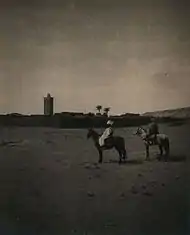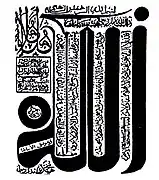Muhammad Bin Al-Qasim al-Qundusi
Muhammad Bin Al-Qāsim al-Qundūsi ( Arabic: محمد بن القاسم القندوسي; died 1861) was a Sufi calligrapher and scholar who lived in Fes, Morocco.[1]
Muhammad Bin Al-Qasim al-Qundusi | |
|---|---|
محمد بن القاسم القندوسي | |
 A Basmala by al-Qundūsi. |
Biography
al-Qundusi was born in Qanaadasa, a community in the desert of the Maghreb, and now within the borders of Algeria.[1] In 1828, he migrated to Fes, where he lived and had a hanout in the herb market, in which he sold herbs.[2]
He lived in relative obscurity, though those who knew him described him as gnostic, saintly, esoterically knowledgable, and spiritually insightful.[3]
He wrote many books transcribed a number of dawawin, or collected works. He conferred upon the Moroccan Alawite Sultan Suleiman a degree in knowledge of Dala'il al-Khayrat, a seminal Sufi text composed by Muhammad al-Jazuli.[4] al-Qundusi passed away in 1861.[1][5]
Calligraphy
He was a talented calligrapher, specializing in a flamboyant style of the Maghrebi script that he innovated. He also wrote a copy of the Quran in 12 volumes which he finished in September 7–8, 1850, and which is kept in al-Khizāna al-Ḥassania.[6]
He drew the name of Allah in the Zawiya of Idriss II in Fes.[7]
Works
His works include:
- التأسيس في مساوي الدنيا ومهاوي إبليس.[9] completed 1838[10]
- البوارق الأحمدية في الحركة والسكونية
- الصلاة الوافية من الأحوال الظلمانية
- التلوين والتمكين في مطلع الصلاة على صاحب الوحي المبين completed 1852
- The Drink of the People of Purity in Prayers upon the Chosen Prophet[11] (or شراب أهل الصفا في الصلاة على النبي المصطفى), also known as طريق المعراج إلى حضرة صاحب التاج completed 1838
- The Grand Elixir of Invocations سيف العناية لمريد الكفاية
Legacy
His works inspired a typeface called Qandus,[13] which was designed by Kristyan Sarkis of TPTQ Arabic, and won the Type Directors Club's 2017 Typeface Design Award.[14]
References
- الأعلام - ج 7 - محمد بن قاسم - نافع بن الحارث (in Arabic). IslamKotob. Archived from the original on 2019-12-20. Retrieved 2019-12-20.
- IslamKotob. الشرب المحضر والسر المنتظر من معين أهل القرن الثالث عشر (in Arabic). IslamKotob.
- "Muhammad al-Qandusi". Awliya Map. Retrieved 2019-12-21.
- أبي عبد الله محمد بن (2015-01-01). طريق المعراج إلى حضرة صاحب التاج (in Arabic). Dar Al Kotob Al Ilmiyah دار الكتب العلمية. ISBN 978-2-7451-7515-1. Archived from the original on 2019-12-20. Retrieved 2019-12-20.
- البهنسي, عفيف (1995 م). معجم مصطلحات الخط العربي والخطاطين (الأولى ed.). بيروت: مكتبة لبنان ناشرون. p. 123. Check date values in:
|date=(help) - الأعلام - خير الدين الزركلي - ج 7 - الصفحة 9
- أبي عبد الله محمد بن (2015-01-01). طريق المعراج إلى حضرة صاحب التاج (in Arabic). Dar Al Kotob Al Ilmiyah دار الكتب العلمية. ISBN 978-2-7451-7515-1. Archived from the original on 2019-12-20. Retrieved 2019-12-20.
- "The Grand Elixir of Invocations". www.goodreads.com. Retrieved 2020-06-13.
- الأعلام - ج 7 - محمد بن قاسم - نافع بن الحارث. IslamKotob. Archived from the original on 2019-12-20. Retrieved 2019-12-20.
- طريق المعراج إلى حضرة صاحب التاج. Dar Al Kotob Al Ilmiyah دار الكتب العلمية. 2015-01-01. ISBN 978-2-7451-7515-1. Archived from the original on 2019-12-20. Retrieved 2019-12-20.
- al-Qandusi, Muhammad Bin al-Qasim (2014). The Drink of the People of Purity. Muhammadan Press. ISBN 9810904134.
- طريق المعراج إلى حضرة صاحب التاج. Dar Al Kotob Al Ilmiyah دار الكتب العلمية. 2015-01-01. ISBN 978-2-7451-7515-1. Archived from the original on 2019-12-20. Retrieved 2019-12-20.
- "Qandus – Laura Meseguer". Retrieved 2019-12-20.
- "Typeface Design 2017". Retrieved 2019-12-20.



